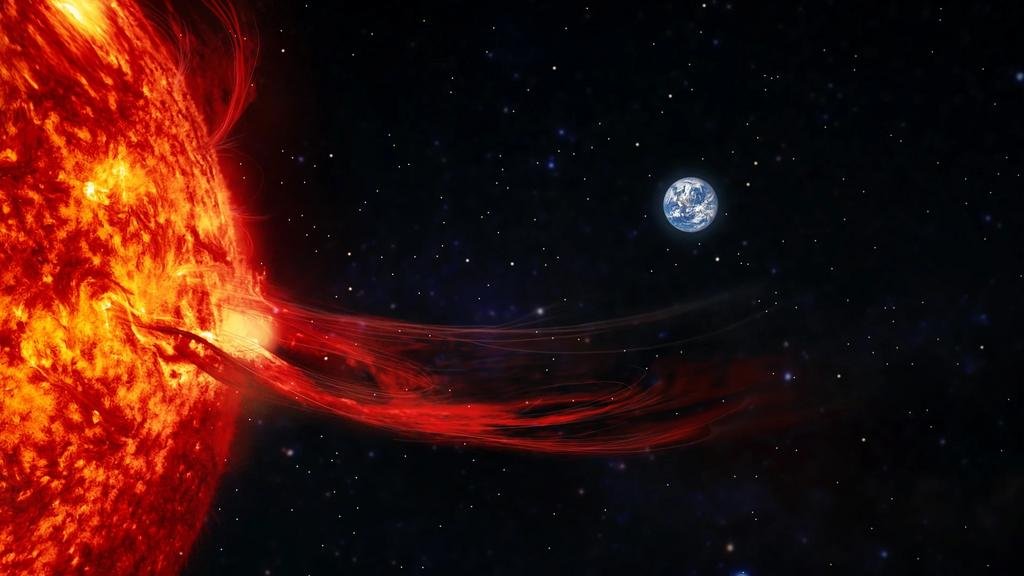
The Earth, in its constant journey around the Sun, is exposed to cyclical solar events/web
In a world where technology is the backbone of modern society, the possibility of a large-scale solar storm is a lurking threat that could trigger a series of catastrophic events on a global scale. Experts warn that the next great solar storm could destroy the entire planet’s technology, plunging humanity into unprecedented uncertainty and challenges.
Earth, in its constant orbit around the Sun, is exposed to cyclical solar events that can have catastrophic consequences. The increase in solar activity associated with solar cycle 25 has led scientists to predict a significant peak in these events in 2024. According to SciTechDaily, this increase in solar activity indicates the possibility of geomagnetic storms that could disable global technology.
Modern satellite instrumentation has improved predictions of these events, but the risk remains high. Recently, the world has witnessed celestial phenomena such as northern and southern lights visible in various parts of the planet, a clear sign of increased solar activity.
A Carrington-sized solar event in 1859 would have had catastrophic consequences due to digital technology and heavy reliance on power grids. According to CleanTechnica, a solar storm of this magnitude could disable satellites, damage power grids and leave large areas without power or communications for months.
Disruption is not limited to digital technology. Basic services such as water supply and transport systems could also be compromised, increasing the risk of a large-scale health and safety crisis. The Planetary Society highlights that these disruptions will lead to the collapse of essential services, adding to the chaos and vulnerability of modern societies.
They warn that another major solar storm could complicate technological devices
The Carrington event of 1859 is considered the most powerful solar storm in recorded history. Discovered by British astronomer Richard Carrington, this phenomenon causes intense geomagnetic effects on Earth such as auroras visible in tropical latitudes, including the Caribbean. In addition to the visual spectacle, the storm caused significant failures in the telegraph system, the most advanced communications technology of the time. Some telegraph operators received electric shocks and equipment caught fire from the current induced by the storm.
This event highlighted for the first time the vulnerability of modern technology to the effects of space and marked the beginning of space meteorology, the science of studying how solar radiation affects Earth.
Given the continuing threat of these events, it is critical to develop more effective forecasting and protection systems. Research is ongoing to improve infrastructure resilience and establish solar emergency response protocols.
The consensus among experts is clear: while solar activity cannot be avoided, its effects can be mitigated through adequate preparation and the implementation of advanced technologies that protect critical infrastructure. Through concerted efforts and greater investment in research, humanity can better prepare for solar storms and their potentially catastrophic impacts.
The next solar storm is not just a scientific possibility, but a reality that could change the course of technological civilization as we know it. Addressing this threat requires global preparedness and a commitment to protecting our fragile digital and energy ecosystem.
Damage to production
In an environment where modern agriculture is dependent on technology, the latest solar storm shows how fragile this dependence is. Farmers in the United States, particularly in Kansas and Nebraska, are facing a crisis in the middle of the corn planting season as their tractors’ GPS systems fail due to intense solar activity.
Intense solar activity in recent days has caused malfunctions in GPS navigation systems that guide high-tech tractors from brands like John Deere. These systems, which are essential for precise planting, are disrupted, forcing farmers to stop their work at critical times. Farmers are on the brink of crisis as the May 15 deadline looms, and any further delay could seriously affect the maize harvest.
21st century tractors, like the John Deere, use real-time kinetics (RTK) systems that enable centimeter-level seeding accuracy. This advanced technology ensures that crops are grown optimally, maximizing yields and minimizing waste. However, any disruption to these systems can result in crop destruction and significant losses.
Recent solar activity has released a large amount of energy that has traveled into space, affecting Earth’s ionosphere. This layer of the upper atmosphere has experienced fluctuations that directly affect satellites, including the delivery of GPS signals. The geomagnetic storm, the strongest in 20 years, reached magnitude G5, the highest in magnitude, causing significant disruptions to radio transmissions and, therefore, to GPS technology.
Basic services like water and transport will also be affected.
The impact of this solar storm is not limited to agriculture. Geomagnetic disturbances can affect a variety of industries that rely on GPS technology, from aviation to oil and gas. Disrupting GPS signals can have devastating consequences, highlighting the vulnerability of modern infrastructure to space phenomena.
This situation has also renewed the debate on the right to repair. Increased reliance on technology and automation in agriculture has led to growing momentum behind laws allowing farmers to repair their own equipment. Currently, many farmers are forced to return to manufacturers for repairs, which can be expensive and time-consuming, especially in emergency situations like the current one.
One of the polar auroras seen last week. They were recorded in the northern and southern hemispheres / on the Internet
